Johann Wolfgang von Goethe
Johann Wolfgang von Goethe (ilul deg 28 ɣuct 1749 deg Frankfurt – yemmut deg 22 meɣres 1832 deg Weimar) d amaru yerna d amassan almani, yura tamedyazt ed tmezgunin, am wakken ay yura ɣef temsal yeqqnen ɣer tfelsuft, tasekla ed tussna.
Tameddurt-ines
ẓregGoethe yura-d yiwen n usefru umi isemma Faust, yerna llan wid ay t-yettwalin d netta ay d asefru aɣezfan igerrzen akk deg tsekla turufit. Goethe yesɛa daɣen aṭas n yisefra igerrzen, am wakken ay yettwassen s wungalen-nnes Wilhelm Meisters Lehrjahre (Iseggasen n welmad n Wilhelm Meister) akked Die Leiden des jungen Werthers (Tidyanin yesseḥzanen n Werthers Ameẓyan). Goethe d yiwen seg yimura ay yuraren dduṛ d ameqran deg tsekla talmanit takelsakt (classique) n tgara n lqern wis 18 ed tezwara n lqern wis 19. Tallit-nnes teɣli-d ed tallit n Lqern n Teftilin akked tallit n trumantit. Goethe yura-d daɣen idṛisen deg tussna, am Tiẓri n Yiniten (La Théorie des Couleurs) akked yeḍrisen yerzan talɣa (forme) n yiɣersiwen ed yemɣan, yerna ayen ay d-yura deg wenrar-a iɛawen aṭas imassanen n ugama n lqern wis 19 (am Charles Darwin) akken ad kemmlen inadiyen-nsen. Goethe yeqdec daɣen d aneṣṣaḥ aɛlayan n yemḍebbren n uduci (duché) n Sachsen-Weimar.
Goethe d Tsertit
ẓregSeg yidis n tsertit, Goethe yella d amagaẓ (conservateur). Asmi ay tenker Tegrawla Tafrensist, Goethe yella yettwali agdud ur izemmer ad yeḥkem iman-nnes i yiman-nnes. Iqeddicen n Goethe deg yedles ed tussna zerɛen deg wakk timura n Turuft, yerna ttekkan deg wesnerni n tmedyazt, n umezgun akked tfelsuft.
Ayen yura
ẓreg- 1771: "Heidenröslein" ("Heath Rosebud"), Tamedyazt
- 1773: "Prometheus", Tamedyazt
- 1773: Götz von Berlichingen, drama
- 1774: Die Leiden des jungen Werthers (The Sorrows of Young Werther), novel
- 1774: "Der König in Thule", Tamedyazt
- 1775: Stella, tragedy in five acts
- 1782: "Der Erlkönig" ("The Alder King"), Tamedyazt
- 1787: Iphigenie auf Tauris (Iphigenia in Tauris), drama
- 1786: Novella, novella
- 1788: Egmont, drama
- 1790: Versuch die Metamorphose der Pflanzen zu erklären (The Metamorphosis of Plants), scientific text
- 1790: Torquato Tasso, drama
- 1790: Römische Elegien (Roman Elegies), poetry collection
- 1793: Die Belagerung von Mainz, (The Siege of Mainz), non-fiction
- 1794: Reineke Fuchs, fable
- 1795: Das Märchen (The Green Snake and the Beautiful Lily), fairy-tale
- 1794–95: Unterhaltungen deutscher Ausgewanderten, novella, which also includes the fairy tale Das Märchen
- 1795–96 (in collaboration with Friedrich Schiller): Die Xenien (The Xenia), collection of epigrams
- 1796: Wilhelm Meisters Lehrjahre (Wilhelm Meister's Apprenticeship), novel
- 1797: "Der Zauberlehrling" (The Sorcerer's Apprentice), Tamedyazt (which was later animated by Disney in Fantasia)
- 1797: "Die Braut von Korinth"[1] ("The Bride of Corinth"), Tamedyazt
- 1798: Hermann und Dorothea (Hermann and Dorothea), epic poem
- 1798: Die Weissagungen des Bakis (The Soothsayings of Bakis)
- 1798/01: Propyläen, periodical
- 1803: Die Natürliche Tochter (The Natural Daughter), play originally intended as the first part of a trilogy on the French revolution
- 1805: "Winckelmann und sein Jahrhundert" ("Winckelmann and His Century")
- 1808: Faust Part One, closet drama
- 1809: Die Wahlverwandtschaften (Elective Affinities), novel
- 1810: Zur Farbenlehre (Theory of Colours), scientific text
- 1811–1830: Aus Meinem Leben: Dichtung und Wahrheit (From my Life: Poetry and Truth) autobiographical work in 4 volumes
- 1813: "Gefunden" ("ttufin"), Tamedyazt
- 1817: Italienische Reise (Italian Journey), journals
- 1819: Westöstlicher Diwan, variously translated as The West-Eastern Divan, The Parliament of East and West, or otherwise; collection of poems in imitation of Sufi and other Muslim poetry, including that of Hafez.
- 1821: Wilhelm Meisters Wanderjahre, oder Die Entsagenden (Wilhelm Meister's Journeyman Years, or the Renunciants/Wilhelm Meister's Travels), Ungal
- 1823: "Marienbad Elegy", Tamedyazt
- 1832: Faust Part Two, closet drama
- 1836: Gespräche mit Goethe (Timeslayin akked Goethe)

